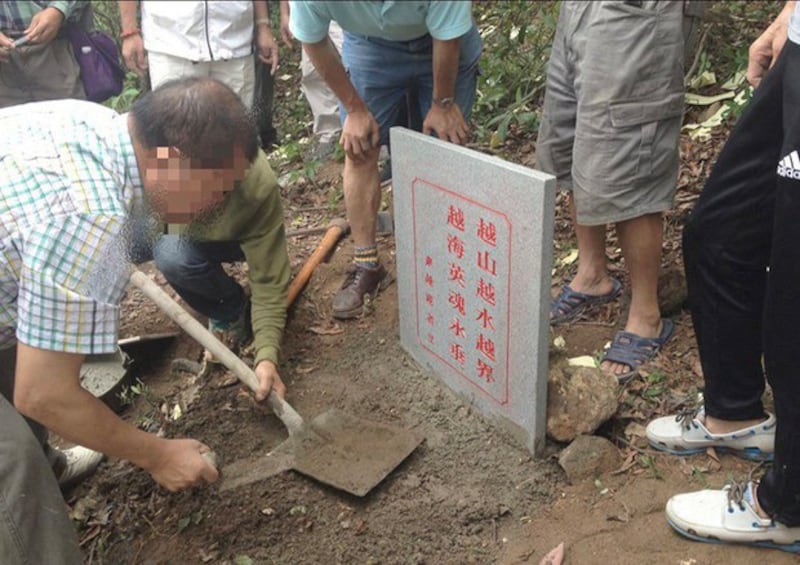At the Eternal Sunset Memorial Park in New Jersey, there is a monument engraved with 176 names in Chinese.
"The spirits of heroes are always here, no matter how many mountains, rivers or oceans lie between," reads the inscription on the black stone, which was inaugurated in a Buddhist ceremony in June 2022.
The monument commemorates young people who died while trying to flee China during Mao Zedong's Cultural Revolution (1966-1976), which saw them sent away from university to live in poverty-stricken rural areas as part of a nationwide policy targeting the country's "educated youth."
Cultural Revolution expert Tan Jialuo said the idea was to commemorate the young victims of a political mass movement in a country where the memorial was unlikely to be removed or tampered with for political reasons.
He said there is room for many more names, and researchers are still looking for confirmed accounts of others who died trying to cross the border to Hong Kong, then a British colony beyond the reach of the turmoil and violence of the Mao era.
"The full toll should be somewhere between 1,000 and 2,000 people," Tan told journalists at the inauguration ceremony. "This number [176] is much more conservative but more accurate."
Tan said he already has hundreds more names he is researching, more than 50 years after the events occurred, and plans a second stele bearing 352 more names.
The project sprang out of an international academic conference on the plight of educated youth during the Cultural Revolution, hosted by the Chinese University of Hong Kong.
Some people set up a memorial in 2014 on Hong Kong's Kat O, or Crooked Island, off Hong Kong's Plover Cove Country Park and the neighboring mainland Chinese city of Shenzhen, which was a popular route for people trying to get to Hong Kong.

Drownings and shark attacks
The New York Times reported peaks in arrivals of refugees known as "freedom swimmers" in Hong Kong from China in May 1971 and again in June 1972, noting that many simply swam across the sea, with some sailing or rowing to Hong Kong.
"Not all the swimmers reach their destination," the paper reported on June 22, 1972. "Some are picked up by Chinese gunboats patrolling the two bays, others are attacked by sharks, and large number become exhausted and drown."
"Already this year, 59 bodies have been recovered in Hong Kong waters," the report said.
It is possible that at least some of those people are now remembered on the New Jersey memorial.
But the Kat O memorial has been left moribund since a political crackdown by the ruling Chinese Communist Party (CCP) on public speech and actions deemed critical of the government. Local people have told mourners they are no longer welcome, so a new location was needed, Tan told RFA.
Hong Kong writer Jin Hong, who now lives in Los Angeles and helped to set up the monument on Kat O, said political pressure had already been growing on memorial activities even before the CCP imposed a national security law on Hong Kong banning criticism of the government.
"Originally, we wanted to buy a piece of land in Hong Kong and make a proper monument," she said. "But that's not achievable given how the situation there has changed."
Jin's research into educated youth fleeing to Hong Kong between 1969 and 1980 suggests that around 200,000 made the perilous trip to Hong Kong, with at least 10,000 deaths along the way. RFA was unable to confirm these estimates independently.
She said before the CCP started putting pressure on the residents of Kat O not to allow mourning parties, large numbers of people would make the trip annually to remember those who died and make offerings of incense, food and wine at the monument.
"In 2014 and 2015, lot of mainlanders came out to make offerings at the small gravestone we put there," she said. "The numbers of people peaked at nearly 300 after 2015, and we chartered a vessel to get everyone there."
Risky in Hong Kong
But the gravestone was vandalized in 2018, and by 2019, the year of mass protests in Hong Kong, the group switched locations to the oyster-farming village of Laufausan instead, before splitting up to make smaller offerings across the city.
Despite the risks of taking part, some people are still making those offerings today in Hong Kong, Jin said.
"People paid their respects this year as well," she said. "They go as tourists to places where educated youths who fled Hong Kong may have landed. Places where you can see the mainland across the sea. That's where they make their offerings."
Chen Jianqin, who helped set up the monument in New Jersey, said the idea for a U.S. monument sprang from contact with Jin's group.
"We contacted Hong Kong, and they said wanted to do this, and so did we," Chen said. "They were going there to make offerings every year, but said it was getting harder and harder [under CCP rule]."
"I thought maybe it would be more meaningful if we could build a monument in the United States and put the name of every educated youth who died on it," Chen said. "In a free country, there's the possibility that it could be permanently preserved. So we started to make preparations."
The team raised tens of thousands of dollars to purchase the grave site at the Eternal Sunset Memorial park, but the biggest hurdle was collecting names for inclusion on the stone, and meticulously confirming all of their stories.
"It had been more than 50 years," he said. "We got everyone we knew to spread the word, and collected names for seven or eight months. We tried our best to make sure it was all correct. Then we ordered the stone."
Translated and edited by Luisetta Mudie.
